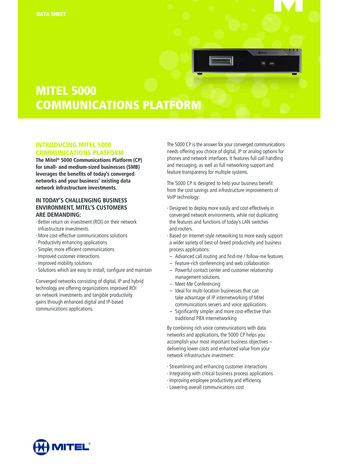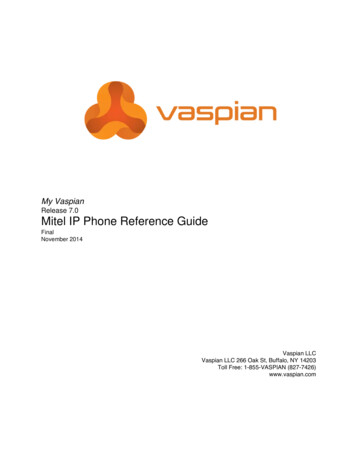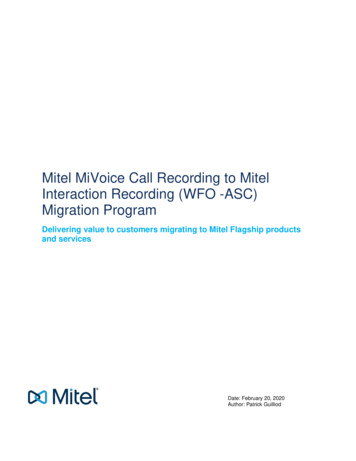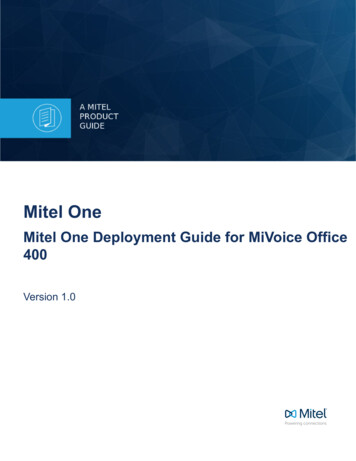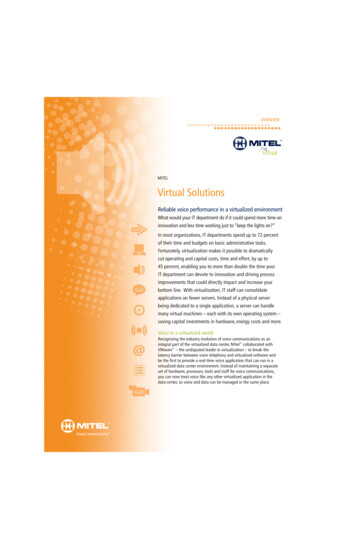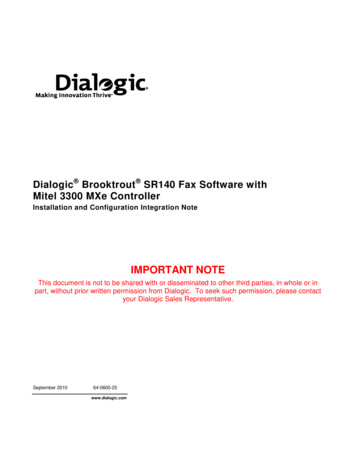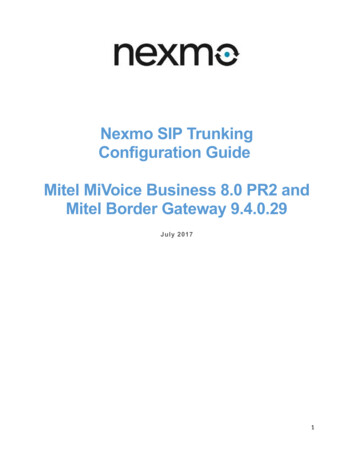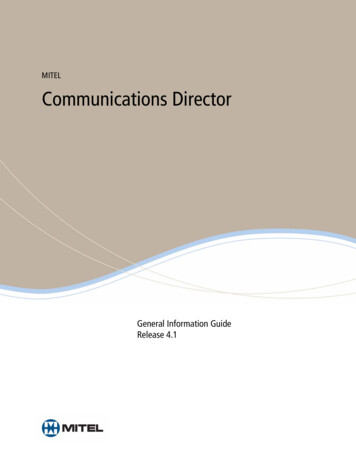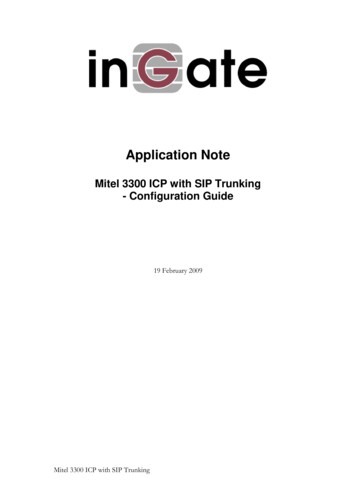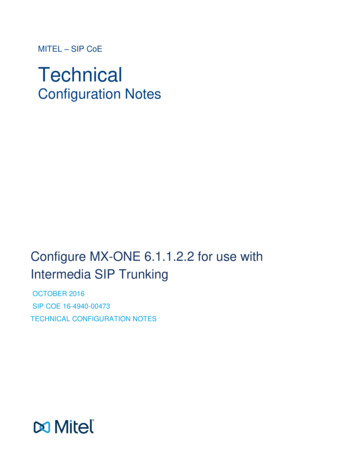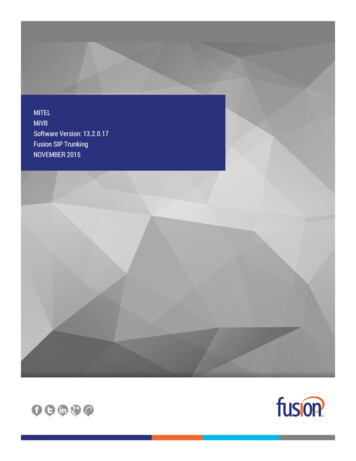
Transcription
MITELMiVBSoftware Version: 13.2.0.17Fusion SIP TrunkingNOVEMBER 2015
FUSION SIP TRUNKINGNOTICEThe information contained in this document is believed to be accurate in all respects but is not warranted by MitelNetworks Corporation (MITEL ). The information is subject to change without notice and should not be construed inany way as a commitment by Mitel or any of its affiliates or subsidiaries. Mitel and its affiliates and subsidiaries assumeno responsibility for any errors or omissions in this document. Revisions of this document or new editions of it may beissued to incorporate such changes.No part of this document can be reproduced or transmitted in any form or by any means - electronic or mechanical - forany purpose without written permission from Mitel Networks Corporation.TRADEMARKSMitel is a trademark of Mitel Networks Corporation.Windows and Microsoft are trademarks of Microsoft Corporation.Other product names mentioned in this document may be trademarks of their respective companies and are herebyacknowledged.Mitel Technical Configuration Notes:Configure the Mitel Voice Business for use with Fusion SIP trunk November 2015, 15-4940-00412 , Trademark of Mitel Networks Corporation Copyright 2015, Mitel Networks Corporation All rights reserved 2015 – Fusion. All rights reserved.FUS-SIPTRUNKING-MiVB-UG-20151207
FUSION SIP TRUNKINGCONTENTS:OVERVIEW . 4INTEROP HISTORY . 4INTEROP STATUS . 4SOFTWARE & HARDWARE SETUP . 4TESTED FEATURES . 5DEVICE LIMITATIONS AND KNOWN ISSUES . 6NETWORK TYPOLOGY . 7CONFIGURATION NOTES . 8MiVB CONFIGURATION NOTES . 8Configuration Template . 8Network Requirements . 8Assumptions for the MiVb Programming . 8Licensing and Option Selection – SIP Licensing . 9Class of Service Assignment . 10Network Elements. 11Network Element Assignment (Proxy) . 12Trunk Attributes (trunk service number) . 13SIP Peer Profile . 14SIP Peer Profile Assignment by Incoming DID . 19ARS Digit Modification Plan . 20ARS Routes . 21ARS Digits Dialed . 22Fax Service Profiles . 23Zone Assignment . 24MITEL BORDER GATEWAY SETUP . 25MiVB SETUP . 25SIP TRUNKS SETUP . 26 2015 – Fusion. All rights reserved.FUS-SIPTRUNKING-MiVB-UG-20151207
FUSION SIP TRUNKINGOVERVIEWThis document provides a reference to Mitel Authorized Solutions providers for configuring the Mitel Voice Business toconnect to Fusion SIP trunk. The different devices can be configured in various configurations depending on your VoIPsolution. This document covers a basic setup with required option setup.INTEROP HISTORYVersionDateReason1November, 2015Initial Interop with Mitel Mitel Voice Business and Fusion SIPtrunkINTEROP STATUSThe Interop of Fusion has been given a Certification status. This service provider or trunking device will be included inthe SIP CoE Reference Guide. The status Fusion achieved is:The most common certification which means Fusion has been tested and/orvalidated by the Mitel SIP CoE team. Product support will provide all necessarysupport related to the interop, but issues unique or specific to the 3rd party willbe referred to the 3rd party as appropriate.SOFTWARE & HARDWARE SETUPThis was the test setup to generate a basic SIP call between Fusion and the Mitel Voice Business.ManufacturerVariantSoftware VersionMitelMitel Voice Business13.2.0.17Mitel5300 Series IP Sets06.03.01.05Mitel6800 Series SIP Sets4.0.0.1096Fusion 2015 – Fusion. All rights reserved.As of November 2015FUS-SIPTRUNKING-MiVB-UG-20151207
FUSION SIP TRUNKINGTESTED FEATURESThis is an overview of the features tested during the Interop test cycle and not a detailed view of the test cases. Pleasesee the SIP Trunk Side Interoperability Test Pans (08-4940-00034) for detailed test cases.FeatureFeature DescriptionBasic CallMaking and receiving a call to and from the Fusion, call holding,transferring, conferencing, busy calls, long calls durations, variable codec.Automatic Call DistributionMaking calls to an ACD environment with RAD treatments, Interflow andOverflow call scenarios and DTMF detection.NuPoint VoicemailTerminating calls to a NuPoint voicemail boxes and DTMF detection.PacketizationForcing the Mitel Voice Business to stream RTP packets differentintervals, of 20ms and 30ms.Personal Ring GroupsReceiving calls from Fusion to a personal ring group. Also moving callsto/from the prime member and group members.VideoVideo Calls inbound and outboundFaxT.38 and G711 Fax CallsNo issues found 2015 – Fusion. All rights reserved.Issues found, cannot recommend to useIssuesIssues foundFUS-SIPTRUNKING-MiVB-UG-20151207
FUSION SIP TRUNKINGDEVICE LIMITATIONS AND KNOWN ISSUESThis is a list of problems or not supported features when Fusion is connected to the Mitel Voice Business.FeatureProblem DescriptionVideoVideo is not supported.An issue was found during T.38 FAX calls where if a re-invite occurs due to sessiontimer expiry during the FAX call the call will drop.T.38 FAXRecommendation: Set the session timer in the SIP peer profile to a value which willprevent the timer form expiring during a T.38 FAX call. Reference defect MN00607790when contacting Mitel Product Support.P-times of other than 20ms are not honored by Fusion.PaketizationRecommendation: Use the default 20ms P-timeOutbound Private Calls 2015 – Fusion. All rights reserved.Private outbound calls are not supported as Fusion requires the main account numberto be present in the “From” SIP header. Mitel removes this number when a call ismarked as private.FUS-SIPTRUNKING-MiVB-UG-20151207
FUSION SIP TRUNKINGNETWORK TOPOLOGYThis diagram shows how the testing network is configured for reference.Figure 1 – Network Typology 2015 – Fusion. All rights reserved.FUS-SIPTRUNKING-MiVB-UG-20151207
FUSION SIP TRUNKINGCONFIGURATION NOTESThis section is a description of how the SIP Interop was configured. These notes should give a guideline how a devicecan be configured in a customer environment and how the MiVb programming was configured in our test environment.Disclaimer: Although Mitel has attempted to setup the interop testing facility as closely as possible to a customerpremise environment, implementation setup could be different onsite. YOU MUST EXERCISE YOUR OWN DUEDILIGENCE IN REVIEWING, planning, implementing, and testing a customer configuration.MiVB CONFIGURATION NOTESThe following steps show how to program a Mitel Voice Business to interconnect with Fusion SIP trunking.Configuration TemplateA configuration template can be found in the same MOL Knowledge Base article as this document. The template is aMicrosoft Excel spreadsheet (.csv format) solely consisting of the SIP Peer profile option settings used during Interoptesting. All other forms should be programmed as indicated below. Importing the template can save you considerableconfiguration time and reduce the likelihood of data-entry errors. Refer to the ICP documentation on how the Importfunctionality is used.Network Requirements There must be adequate bandwidth to support the voice over IP. As a guide, the Ethernet bandwidth is approx85 Kb/s per G.711 voice session and 29 Kb/s per G.729 voice session (assumes 20ms packetization). As anexample, for 20 simultaneous SIP sessions, the Ethernet bandwidth consumption will be approx 1.7 Mb/s forG.711 and 0.6Mb/s for G.729. Almost all Enterprise LAN networks can support this level of traffic without anyspecial engineering. Please refer to the MiVb Engineering guidelines for further information. For high quality voice, the network connectivity must support a voice-quality grade of service (packet loss 1%,jitter 30ms, one-way delay 80ms).Assumptions for the MiVb Programming The SIP signaling connection uses UDP on Port 5060. 2015 – Fusion. All rights reserved.FUS-SIPTRUNKING-MiVB-UG-20151207
FUSION SIP TRUNKINGLicensing and Option Selection – SIP Licensing Ensure that the MiVb is equipped with enough SIP trunking licenses for the connection to the Fusion SIP trunk.This can be verified within the License and Option Selection form. Enter the total number of licenses in the SIP Trunk Licences field. This is the maximum number of SIP trunksessions that can be configured in the MiVb to be used with all service providers, applications and SIP trunkingdevices.Figure 2 – License and Option Selection Form 2015 – Fusion. All rights reserved.FUS-SIPTRUNKING-MiVB-UG-20151207
FUSION SIP TRUNKINGClass of Service AssignmentThe Class of Service Options Assignment form is used to create or edit a Class of Service and specify its options. Classesof Service, identified by Class of Service numbers, are referenced in the Trunk Attributes form for SIP trunks.Many different options may be required for your site deployment, but ensure that “Public Network Access via DPNSS”Class of Service Option is configured for all devices that make outgoing calls through the SIP trunks in the MiVb.Also, under General tab, ensure that the following options are enabled (see Figure 3): Busy Override Security (in Busy Override section) set to Yes Campon Tone Security (in Fax section) set to Yes Public Network Access via DPNSS (in Trunk section) set to Yes Fax Capable if a Fax device is connected to this port or uses this trunk YESFigure 3 – Class of Service Form 2015 – Fusion. All rights reserved.FUS-SIPTRUNKING-MiVB-UG-20151207
FUSION SIP TRUNKINGNetwork ElementsCreate a network element for a SIP Peer “Fusion” as shown in Figure 4.If you want to use compression set the Zone to be a different value than that of the ICP. If no compression is requiredyou can set the zone to that of the ICP, 1 by default.In our setup the SIP trunks do register so the registration address needs to be filled in.Set the transport to Default or UDP and port to 5060.Figure 4 – Network Element Form 2015 – Fusion. All rights reserved.FUS-SIPTRUNKING-MiVB-UG-20151207
FUSION SIP TRUNKINGNetwork Element Assignment (Proxy)In addition, depending on your configuration, a Proxy may need to be configured to route SIP data to the serviceprovider. If you have a Proxy server installed in your network, the MIVB will require knowledge of this by programmingthe Proxy as a network element then referencing this proxy in the SIP Peer profile assignment (later in this document).Figure 5 – Network Element Assignment (Proxy) 2015 – Fusion. All rights reserved.FUS-SIPTRUNKING-MiVB-UG-20151207
FUSION SIP TRUNKINGTrunk Attributes (trunk service number)The Trunk Attributes is defined for Trunk Service Number (16), which will be used to direct incoming calls to an answerpoint in the MiVb.Set the number of Class of Service that was configured in the section above.Program the Non-dial In Trunks Answer Point according to the site requirements and what type of service was orderedfrom your service provider.The figure below shows configuration for incoming DID calls. The MiVb will absorb the first 3 digits of the DID numberreceived from the Fusion SIP trunk leaving 6 digits for the MiVb to translate and route the call.For example, the Fusion SIP trunk delivers number 613-592-5660 to the MiVb. The MiVb will absorb the first 3 digits(613) leaving the Mitel MiVb 5925660 to routre the call. The digits 5925660 must be programmed as a valid dialablenumber in the MiVb. As an alternative way, you can create a System Speed Call number to associate number 5925660with the real telephone extension on MiVb. Please refer to the MiVb System Administration documentation for furtherprogramming information.Figure 6 – Trunk Attributes (trunk service number) 2015 – Fusion. All rights reserved.FUS-SIPTRUNKING-MiVB-UG-20151207
FUSION SIP TRUNKINGSIP Peer ProfileThe recommended connectivity via SIP Trunking does not require additional physical interfaces. IP/Ethernet connectivityis the part of the MiVb platform. The SIP Peer Profile should be configured as shown in Figures 7 through 12.Basic (Figure 7):Network Element: The selected SIP Peer Profile needs to be associated with previously created “Fusion” NetworkElement.Registration User Name: Leave this field blank.Address Type: Select the IP Address of your Mitel MiVb.Maximum Simultaneous Calls: This entry should be configured to maximum number of SIP trunks provided by Fusion.Outbound Proxy Server: Not required in our test setup.SMDR Tag: If Call Detail Records are required for SIP Trunking, the SMDR Tag should be configured (by default there isno SMDR and this field is left blank).Trunk Service: Enter the trunk attributes number that was previously configured (16) in this configuration.Authentication Options: User name and password as supplied by Fusion.Figure 7 – SIP Peer Profile Form 2015 – Fusion. All rights reserved.FUS-SIPTRUNKING-MiVB-UG-20151207
FUSION SIP TRUNKINGCall Routing (Figure 8):Leave the default settings intact, as shown.Figure 8 – SIP Peer Profile Form (continues) 2015 – Fusion. All rights reserved.FUS-SIPTRUNKING-MiVB-UG-20151207
FUSION SIP TRUNKINGCalling Line ID (Figure 9):The Default CPN (Calling Party Number) is applied to all outgoing calls. You can use the one of DID numbers assigned onthe trunk by the provider.CPN Restriction: By default, this parameter is set to “No” to not hide the caller’s number. You can enable it if required.Figure 9 – SIP Peer Profile Form (continues) 2015 – Fusion. All rights reserved.FUS-SIPTRUNKING-MiVB-UG-20151207
FUSION SIP TRUNKINGSDP Options (Figure 10):Set the options as depicted below unless there is a specific reason to change them.Figure 10 – SIP Peer Profile Form (continues) 2015 – Fusion. All rights reserved.FUS-SIPTRUNKING-MiVB-UG-20151207
FUSION SIP TRUNKINGSignaling and Header Manipulation (Figure 11):Figure 11 depicts how the test environment was configured.Figure 11 – SIP Peer Profile form 2015 – Fusion. All rights reserved.FUS-SIPTRUNKING-MiVB-UG-20151207
FUSION SIP TRUNKINGTimers (Figure 12):Session Timers: Figure 12 is how the timers were set for our test environment. The session timer was increased from thedefault to accommodate T.38 FAX calls as stated in Device Limitations and Know Issues section.Figure 12 – SIP Peer Profile form (continues)For Key Press Event and Profile Information tabs, leave the default settings intact.SIP Peer Profile Assignment by Incoming DIDIn some situations calls from anonymous PSTN callers may be rejected at MiVb with Not Found message. To deliversuch calls to Mitel’s extensions, make sure to associate Fusion’s DID number(s) with the SIP Peer Profile we configuredearlier. 2015 – Fusion. All rights reserved.FUS-SIPTRUNKING-MiVB-UG-20151207
FUSION SIP TRUNKINGARS Digit Modification PlanEnsure that Digit Modification for outgoing calls to Fusion SIP trunk absorbs or inject additional digits according to yourdialling plan. In our test environment, we will be absorbing 1 digit and will not inject any digits, as shown in Figure 13. Asper our test environment, we need to dial 952 to access Fusion SIP trunk; thus, digit 952 will be absorbed and no digitswill be preceding the dialled number. For instance, if caller dials 9526135555660, MiVb will send to the SIP trunk thefollowing: 6135555660.Figure 13 – ARS Digit Modification Form 2015 – Fusion. All rights reserved.FUS-SIPTRUNKING-MiVB-UG-20151207
FUSION SIP TRUNKINGARS RoutesCreate a route to Fusion SIP trunk. In this test environment, the SIP trunk is assigned to Route Number 9. Choose SIPTrunk as a routing medium and choose the SIP Peer Profile and ARS Digit Modification entry created earlier.Figure 14 – ARS Route Form 2015 – Fusion. All rights reserved.FUS-SIPTRUNKING-MiVB-UG-20151207
FUSION SIP TRUNKINGARS Digits DialedARS initiates the routing of trunk calls when certain digits are dialed from an extension. In this test environment, whenuser dials 952, the call will be routed to Fusion SIP trunk (i.e. to Route 9). For outbound calling, MiVb expects 11 digits tobe dialed after dialing of 957. See Figure 15 for details.Figure 15 – ARS Digit Dialed form 2015 – Fusion. All rights reserved.FUS-SIPTRUNKING-MiVB-UG-20151207
FUSION SIP TRUNKINGFax Service ProfilesThis form allows you to define the settings for FAX communication over the IP network. You can modify the defaultsettings for the:Inter-zone FAX profile: defines the FAX settings between different zones in the network. There is only one Inter-zone FAXprofile; it applies to all inter-zone FAX communication. It defaults to V.29, 7200bps. It defines the settings for FAX Relay(T.38) FAX communication.Intra-zone FAX profile: defines the FAX settings within each zone in the network. Profile 1 defines the settings for G.711 pass through communication.Profile 2 to 64 define the settings for FAX Relay (T.38) FAX communication.All zones default to G.711 pass through communication (Profile 1).Figure 16 – Fax Configuration 2015 – Fusion. All rights reserved.FUS-SIPTRUNKING-MiVB-UG-20151207
FUSION SIP TRUNKINGZone AssignmentBy default, all zones are set to Intra-zone FAX Profile 1.Based on your network diagram, assign the Intra-zone FAX Profiles to the Zone IDs of the zones. If audio compression isrequired within the same zone, set Intra-Zone Compression to “Yes”. Fusion uses the Inter-zone FAX Profile.Figure 17 – Zone Assignment 2015 – Fusion. All rights reserved.FUS-SIPTRUNKING-MiVB-UG-20151207
FUSION SIP TRUNKINGMITEL BORDER GATEWAY SETUPMiVB SETUP1.2.3.To program an MIVB into the MBG, click on Service Configuration - ICP’s - .Enter a name for the MIVB.Enter the IP address of the MIVB and select the Type as Mitel Voice Business.Figure 18 – ICP setup 2015 – Fusion. All rights reserved.FUS-SIPTRUNKING-MiVB-UG-20151207
FUSION SIP TRUNKINGSIP TRUNKS SETUP1.2.Under the Services Configuration tab, click on SIP trunking and then click on the sign to add a SIP trunk”.Enter the SIP trunk’s details for the as provided by Fusion.a. Name – is the name of the trunk.b. Remote trunk endpoint address – the public IP address/FQDN address of the provider’s switch orgateway (this address should be given to you by the provider, e.g. Fusion).c. Local/Remote RTP framesize (ms) – is the packetization rate you want to set on this trunk, Auto or20ms in this case.d. PRACK – Use master setting.e. Routing rule one – it allows routing of any digits to the selected MiVb’sThe rest of the settings are optional and could be configured if required. Click Save button.Figure 19 – Services - SIP Trunking Setup 2015 – Fusion. All rights reserved.FUS-SIPTRUNKING-MiVB-UG-20151207
FUSION SIP TRUNKING 2015 – Fusion. All rights reserved.FUS-SIPTRUNKING-MiVB-UG-20151207
received from the Fusion SIP trunk leaving 6 digits for the MiVb to translate and route the call. For example, the Fusion SIP trunk delivers number 613-592-5660 to the MiVb. The MiVb will absorb the first 3 digits (613) leaving the Mitel MiVb 5925660 to routre the call. The digits 5925660 must be programmed as a valid dialable number in the MiVb.
